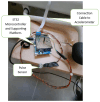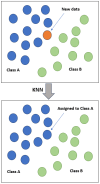Comparison of Machine Learning Algorithms for Heartbeat Detection Based on Accelerometric Signals Produced by a Smart Bed
- PMID: 38544162
- PMCID: PMC10974326
- DOI: 10.3390/s24061900
Comparison of Machine Learning Algorithms for Heartbeat Detection Based on Accelerometric Signals Produced by a Smart Bed
Abstract
This work aims to compare the performance of Machine Learning (ML) and Deep Learning (DL) algorithms in detecting users' heartbeats on a smart bed. Targeting non-intrusive, continuous heart monitoring during sleep time, the smart bed is equipped with a 3D solid-state accelerometer. Acceleration signals are processed through an STM 32-bit microcontroller board and transmitted to a PC for recording. A photoplethysmographic sensor is simultaneously checked for ground truth reference. A dataset has been built, by acquiring measures in a real-world set-up: 10 participants were involved, resulting in 120 min of acceleration traces which were utilized to train and evaluate various Artificial Intelligence (AI) algorithms. The experimental analysis utilizes K-fold cross-validation to ensure robust model testing across different subsets of the dataset. Various ML and DL algorithms are compared, each being trained and tested using the collected data. The Random Forest algorithm exhibited the highest accuracy among all compared models. While it requires longer training time compared to some ML models such as Naïve Bayes, Linear Discrimination Analysis, and K-Nearest Neighbour Classification, it keeps substantially faster than Support Vector Machine and Deep Learning models. The Random Forest model demonstrated robust performance metrics, including recall, precision, F1-scores, macro average, weighted average, and overall accuracy well above 90%. The study highlights the better performance of the Random Forest algorithm for the specific use case, achieving superior accuracy and performance metrics in detecting user heartbeats in comparison to other ML and DL models tested. The drawback of longer training times is not too relevant in the long-term monitoring target scenario, so the Random Forest model stands out as a viable solution for real-time ballistocardiographic heartbeat detection, showcasing potential for healthcare and wellness monitoring applications.
Keywords: accelerometer sensor; artificial intelligence algorithm; deep learning; heartbeat detection; machine learning; smart bed.
Conflict of interest statement
The authors declare no conflict of interest.
Figures














Similar articles
-
Machine Learning Based Identification of Microseismic Signals Using Characteristic Parameters.Sensors (Basel). 2021 Oct 20;21(21):6967. doi: 10.3390/s21216967. Sensors (Basel). 2021. PMID: 34770274 Free PMC article.
-
Machine Learning Hybrid Model for the Prediction of Chronic Kidney Disease.Comput Intell Neurosci. 2023 Mar 14;2023:9266889. doi: 10.1155/2023/9266889. eCollection 2023. Comput Intell Neurosci. 2023. PMID: 36959840 Free PMC article.
-
Prediction and Diagnosis of Breast Cancer Using Machine and Modern Deep Learning Models.Asian Pac J Cancer Prev. 2024 Mar 1;25(3):1077-1085. doi: 10.31557/APJCP.2024.25.3.1077. Asian Pac J Cancer Prev. 2024. PMID: 38546090 Free PMC article.
-
Machine learning applications to neuroimaging for glioma detection and classification: An artificial intelligence augmented systematic review.J Clin Neurosci. 2021 Jul;89:177-198. doi: 10.1016/j.jocn.2021.04.043. Epub 2021 May 13. J Clin Neurosci. 2021. PMID: 34119265
-
Shallow and deep learning classifiers in medical image analysis.Eur Radiol Exp. 2024 Mar 5;8(1):26. doi: 10.1186/s41747-024-00428-2. Eur Radiol Exp. 2024. PMID: 38438821 Free PMC article. Review.
Cited by
-
Benchmarking Accelerometer and CNN-Based Vision Systems for Sleep Posture Classification in Healthcare Applications.Sensors (Basel). 2025 Jun 18;25(12):3816. doi: 10.3390/s25123816. Sensors (Basel). 2025. PMID: 40573703 Free PMC article.
References
-
- Dare—Digital Lifelong Prevention. [(accessed on 12 February 2024)]. Available online: https://www.fondazionedare.it/
-
- Il Digitale Strumento Di Prevenzione Sanitaria: Il Progetto Dare. [(accessed on 11 November 2023)]. Available online: https://www.agendadigitale.eu/sanita/il-digitale-strumento-di-prevenzion...
-
- Speranza M., López-López J.D., Schwartzmann P., Morr I., Rodríguez-González M.J., Buitrago A., Pow-Chon-Long F., Passos L.C., Rossel V., Perna E.R., et al. Cardiovascular Complications in Patients with Heart Failure and COVID-19: Cardio COVID 19–20 Registry. J. Cardiovasc. Dev. Dis. 2024;11:34. doi: 10.3390/jcdd11020034. - DOI - PMC - PubMed
MeSH terms
LinkOut - more resources
Full Text Sources

